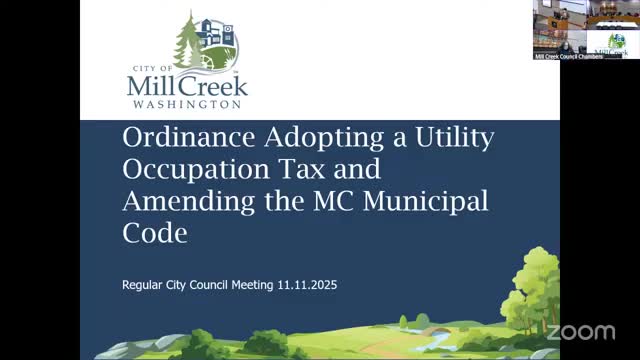Mill Creek council adopts 5% utility occupation tax, sets June 1, 2026 effective date
November 12, 2025 | Mill Creek, Snohomish County, Washington
This article was created by AI summarizing key points discussed. AI makes mistakes, so for full details and context, please refer to the video of the full meeting. Please report any errors so we can fix them. Report an error »

Mill Creek, Wash. — The Mill Creek City Council voted to adopt a new utility occupation tax ordinance on Nov. 11, approving a 5% levy on most utility services and a matching manufactured-gas use tax.
Finance Director Ermina Lombard presented five scenarios for a municipal utility-business occupation tax, explaining the legal framework and projected revenues. "At 1% we can raise about half a million dollars a year," Lombard told the council as she walked through baseline and options ranging from 0% to 6%, and explained the schedule that would make an ordinance effective June 1, 2026 with first collections in July 2026. She also outlined a roughly 51-day referendum window and the county’s special-election deadlines if a petition qualified.
Mayor Holsclaw, who made the motion to impose a 5% rate, described the tax as "a necessary evil," arguing that the city faces structural expenditure pressures and that the revenue cushion would allow Mill Creek to sustain services through 2030 while pursuing strategic priorities. Council debate focused on trade-offs between a smaller initial rate and the long-term durability of city services; opponents urged asking voters or pursuing deeper cuts instead.
Council voted on the main motion to impose 5% on listed utilities (excluding storm and surface water) and the separate measure to include brokered/manufactured natural gas at the same rate. The first motion passed 5–2; the brokered-gas inclusion passed 6–1. A final vote to adopt the full ordinance amending Title 3 of the Mill Creek Municipal Code (new chapters 3.14 and 3.18) passed 5–2.
The ordinance includes standard provisions setting definitions, allowable deductions, filing and examination procedures, penalties for late or underpayment, an appeals process, and authorization for the finance director to promulgate implementing rules. Lombard said staff modeled the first year conservatively as roughly six months of revenue because of implementation timing and the potential referendum period.
Council also gave staff direction to identify $160,000 of permanent, sustainable budget cuts to reduce reliance on fund balance — a target discussed as the remaining near-term gap under a lower tax-rate scenario. City Manager Martin Yamamoto said departments have already been tasked to look for discretionary reductions and promised to return with options for council consideration in December.
What’s next: The ordinance sets an effective date of June 1, 2026, with the first collection projected for July 25, 2026. If a valid referendum petition is filed, the city would place the measure on the next applicable special election per county deadlines.
Finance Director Ermina Lombard presented five scenarios for a municipal utility-business occupation tax, explaining the legal framework and projected revenues. "At 1% we can raise about half a million dollars a year," Lombard told the council as she walked through baseline and options ranging from 0% to 6%, and explained the schedule that would make an ordinance effective June 1, 2026 with first collections in July 2026. She also outlined a roughly 51-day referendum window and the county’s special-election deadlines if a petition qualified.
Mayor Holsclaw, who made the motion to impose a 5% rate, described the tax as "a necessary evil," arguing that the city faces structural expenditure pressures and that the revenue cushion would allow Mill Creek to sustain services through 2030 while pursuing strategic priorities. Council debate focused on trade-offs between a smaller initial rate and the long-term durability of city services; opponents urged asking voters or pursuing deeper cuts instead.
Council voted on the main motion to impose 5% on listed utilities (excluding storm and surface water) and the separate measure to include brokered/manufactured natural gas at the same rate. The first motion passed 5–2; the brokered-gas inclusion passed 6–1. A final vote to adopt the full ordinance amending Title 3 of the Mill Creek Municipal Code (new chapters 3.14 and 3.18) passed 5–2.
The ordinance includes standard provisions setting definitions, allowable deductions, filing and examination procedures, penalties for late or underpayment, an appeals process, and authorization for the finance director to promulgate implementing rules. Lombard said staff modeled the first year conservatively as roughly six months of revenue because of implementation timing and the potential referendum period.
Council also gave staff direction to identify $160,000 of permanent, sustainable budget cuts to reduce reliance on fund balance — a target discussed as the remaining near-term gap under a lower tax-rate scenario. City Manager Martin Yamamoto said departments have already been tasked to look for discretionary reductions and promised to return with options for council consideration in December.
What’s next: The ordinance sets an effective date of June 1, 2026, with the first collection projected for July 25, 2026. If a valid referendum petition is filed, the city would place the measure on the next applicable special election per county deadlines.
Don't Miss a Word: See the Full Meeting!
Go beyond summaries. Unlock every video, transcript, and key insight with a Founder Membership.
✓
Get instant access to full meeting videos
✓
Search and clip any phrase from complete transcripts
✓
Receive AI-powered summaries & custom alerts
✓
Enjoy lifetime, unrestricted access to government data
30-day money-back guarantee

